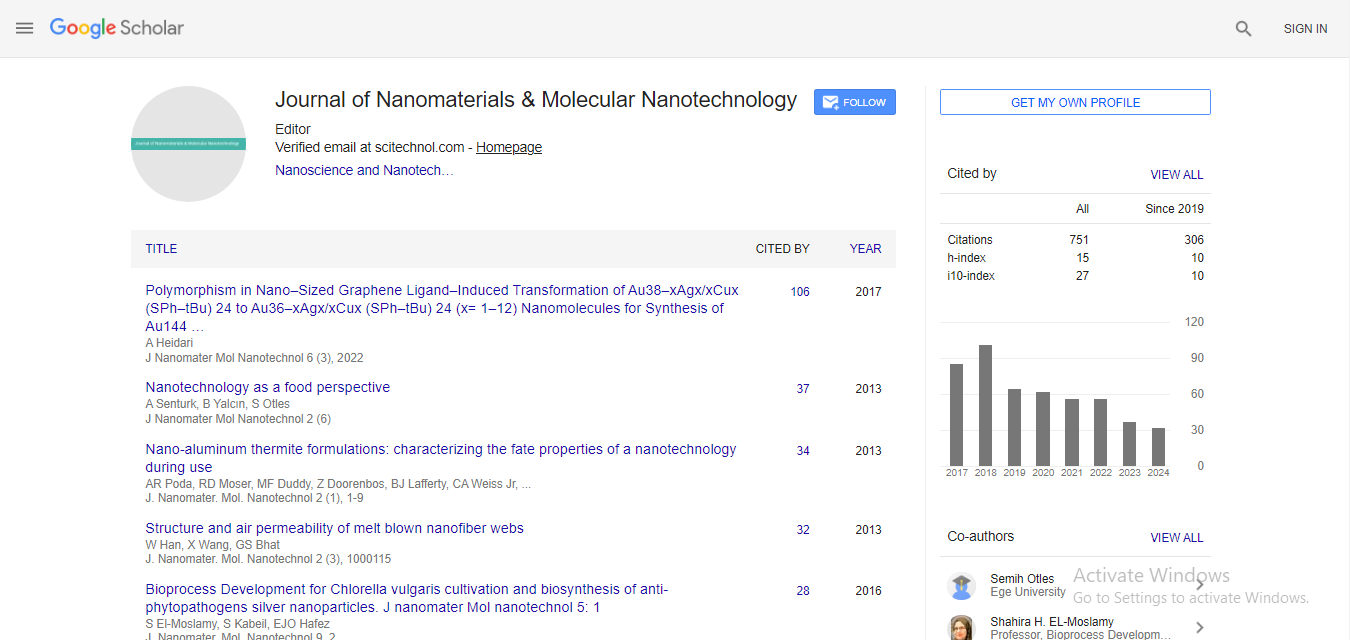Ultrasonic waves and temperature effects on graphene structure fabricated by electrochemical exfoliation method
Razieh Bakhshandeh
Alzahra University, Iran
: J Nanomater Mol Nanotechnol
Abstract
The vast majority of attention among theoretical and experimental researchers has been focused on graphene due to its potential applications in electronic devices. Fabricate of high quality graphene is a great challenge because graphene sheets are extremely affected by external factors. Cognition of external factors plays an important role in the manufacturing process of graphene sheets. Moreover, identification of these factors to the manufacturing of high quality graphene sheets is too important. Therefore, we select and investigate ultrasonic waves and temperature as an external factor in this research. In order to fabricate graphene sheets, we used exfoliation electrochemical method. Firstly, we applied ultrasonic waves and temperature factor to homogenize the electrolyte of the first sample (S1). It has been fabricated by using 420 W ultrasonic waves. In the next step, we heated the second sample (S2) up to 100°C with the aid of heating stirrer. Finally, our fabricated samples are studied thoroughly by using Fourier transform infrared spectroscopy (FTIR), ultraviolet-visible (UV-VIS), x-ray diffraction (XRD), energy-dispersive x-ray spectroscopy as well as scanning electron microscope (EDX and SEM) and transmission electron microscopy (TEM). As a result, we discovered that ultrasonic waves play an important role in declining the oxygen group rate in graphene. Furthermore, the applied heat leads to increase of the carbon/oxygen ratio and size reduction of the graphene sheets. The results show that ultrasonic waves and temperature have positive and negative effects on some features of graphene sheets. Recent Publications 1. K Chen and D Xue (2016) Materials chemistry toward electrochemical energy storage. Journal of Materials Chemistry A 4(20):7522-7537. 2. Khaled Parvez, Zhong-Shuai Wu, Rongjin Li and Klaus Müllen (2014) Exfoliation of graphite into graphene in aqueous solutions of inorganic salts. Journal of the American Chemical Society 136:6083-6091. 3. C Wu, Q Cheng, K Wu, G Wu and Q Li (2014) Graphene prepared by one-pot solvent exfoliation as a highly sensitive platform for electrochemical sensing. Analytica Chimica Acta 825:26-33. 4. Z Zang, X Zeng, M Wang, W Hu, C Liu and X Tang (2017) Tunable photoluminescence of water-soluble AgInZnS - graphene oxide (GO) nanocomposites and their application in vivo bio-imaging. Sensor and Actuator B: Chemical 19:1179-1186. 5. J Wei, Z Zang, Y Zhang, M Wang, J Du and X Tang (2017) Enhanced performance of light-controlled conductive switching in hybrid cuprous oxide/reduced graphene oxide (Cu2O/rGO) nano composites. Optics Letters 42:911-914.
Biography
Razieh Bakhshandeh is graduated with distinction in Master degree of experimental condensed matter physics from Alzahra University, Tehran. She is interested in examination of electrochemical exfoliation technique for fabricating graphene sheets to investigate the effects of external factors on the properties of graphene plates.
E-mail: Raziyhebakhshandeh@gmail.com
 Spanish
Spanish  Chinese
Chinese  Russian
Russian  German
German  French
French  Japanese
Japanese  Portuguese
Portuguese  Hindi
Hindi 



